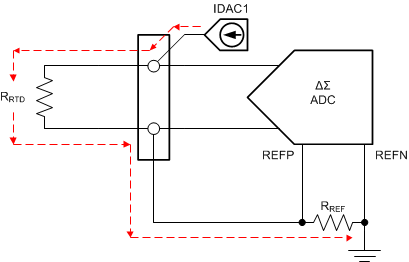SBAA275A June 2018 – March 2023 ADS1120 , ADS112C04 , ADS112U04 , ADS1147 , ADS1148 , ADS114S06 , ADS114S06B , ADS114S08 , ADS114S08B , ADS1220 , ADS122C04 , ADS122U04 , ADS1247 , ADS1248 , ADS124S06 , ADS124S08 , ADS125H02 , ADS1260 , ADS1261 , ADS1262 , ADS1263
- A Basic Guide to RTD Measurements
- 1RTD Overview
-
2RTD Measurement Circuits
- 2.1 Two-Wire RTD Measurement With Low-Side Reference
- 2.2 Two-Wire RTD Measurement With High-Side Reference
- 2.3 Three-Wire RTD Measurement, Low-Side Reference
- 2.4 Three-Wire RTD Measurement, Low-Side Reference, One IDAC Current Source
- 2.5 Three-Wire RTD Measurement, High-Side Reference
- 2.6 Four-Wire RTD Measurement, Low-Side Reference
- 2.7 Two Series Two-Wire RTD Measurements, Low-Side Reference
- 2.8 Two Series Four-Wire RTD Measurements
- 2.9 Multiple Two-Wire RTD Measurements
- 2.10 Multiple Three-Wire RTD Measurements
- 2.11 Multiple Four-Wire RTD Measurements in Parallel
- 2.12 Universal RTD Measurement Interface With Low-Side Reference
- 2.13 Universal RTD Measurement Interface With High-Side Reference
- 3Summary
- 4Revision History
1.4 Ratiometric Measurements
RTD measurements with an ADC are typically made with a ratiometric measurements. Figure 1-4 shows the basic topology of a ratiometric measurement. Shown are the ADC with a two-wire RTD and a reference resistor RREF. A single excitation current source (IDAC1) is used to excite the RTD as well as to establish a reference voltage across RREF for the ADC.
 Figure 1-4 Example of a Ratiometric RTD Measurement
Figure 1-4 Example of a Ratiometric RTD MeasurementWith IDAC1, the ADC measures the voltage across the RTD using the voltage across RREF as the reference. This provides an output code that is proportional to the ratio of the RTD voltage and the reference voltage as shown in Equation 3. Ratiometric measurements will only produce positive output data, assuming zero offset error. For a fully-differential measurement, this is only the positive half of the full-scale range of the ADC, reducing the measurement resolution by one bit. The following equations assume a 24-bit bipolar ADC, with ±VREF as the full-scale range of the ADC.
The currents cancel so that the equation reduces to Equation 4:
In the end, the RTD resistance can be represented from the code as a function of the reference resistance.
The measurement depends on the resistive value of the RTD and the reference resistor RREF, but not on the IDAC1 current value. Therefore, the absolute accuracy and temperature drift of the excitation current does not matter. In a ratiometric measurement, as long as there is no current leakage from IDAC1 outside of this circuit, the measurement depends only on RRTD and RREF. ADC conversions do not need to be translated to voltage.
Assuming the ADC has a low gain error, RREF is often the largest source of error. The reference resistor must be a high accuracy precision resistor with low drift. Any error in the reference resistance becomes a gain error in the measurement.